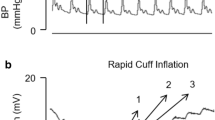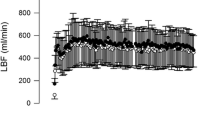Abstract
To investigate whether venous occlusion plethysmography (VOP) may be used to measure high rates of arterial inflow associated with exercise, venous occlusions were performed at rest, and following dynamic handgrip exercise at 15, 30, 45, and 60% of maximum voluntary contraction (MVC) in seven healthy males. The effect of including more than one cardiac cycle in the calculation of blood flow was assessed by comparing the cumulative blood flow over one, two, three, or four cardiac cycles. The inclusion of more than one cardiac cycle at 30 and 60% MVC, and more than two cardiac cycles at 15 and 45% MVC resulted in a lower blood flow compared to using only the first cardiac cycle (P < 0.05). Despite the small time interval over which arterial inflow was measured (~1 s), this did not affect the reproducibility of the technique. Reproducibility (coefficient of variation for arterial inflow over three trials) tended to be poorer at the higher workloads, although this was not significant (12.7 ± 6.6, 16.2 ± 7.3, and 22.9 ± 9.9% for the 15, 30, and 45% MVC workloads; P = 0.102). There was also a tendency for greater reproducibility with the inclusion of more cardiac cycles at the highest workload, but this did not reach significance (P = 0.070). In conclusion, when calculated over the first cardiac cycle only during venous occlusion, high rates of forearm blood flow can be measured using VOP, and this can be achieved without a significant decrease in the reproducibility of the measurement.


Similar content being viewed by others
References
Alomari MA, Solomito A, Reyes R, Khalil SM, Wood RH, Welsch MA (2004) Measurements of vascular function using strain-gauge plethysmography: technical considerations, standardization, and physiological findings. Am J Physiol Heart Circ Physiol 286:H99–H107
Arnold J, Ribeiro J, Colucci W (1990) Muscle blood flow during forearm exercise in patients with severe heart failure. Circulation 82:465–472
Barendsen GJ, Venema H, van den Berg J (1971) Semicontinuous blood flow measurement by triggered venous occlusion plethysmography. J Appl Physiol 31:288–291
Beaconsfield P, Ginsburg J (1955) Effect of changes in limb posture on peripheral blood flow. Circ Res 3:478–482
Brown E, Greenfield DM, Goei JS, Plassaras G (1966) Filling and emptying of the low-pressure blood vessels of the human forearm. J Appl Physiol 21:573–582
Fehling P, Arciero P, MacPherson C, Smith D (1999) Reproducibility of resting peripheral blood flow using strain gauge plethysmography. Int J Sports Med 20:555–559
Formel PF, Doyle JT (1957) Rationale of venous occlusion plethysmography. Circ Res 5:354–356
Green S, Langberg H, Skovgaard D, Bulow J, Kjar M (2000) Interstitial and arterial-venous [K+] in human calf muscle during dynamic exercise: effect of ischaemia and relation to muscle pain. J Physiol 529:849–861
Hellige G, Ensink FB, Baller D, Prennschutz-Schutzenau H, Sigmund-Duchanova H, Zipfel J (1979) Measurement of arterial and venous reactivity by an advanced strain gauge plethysmograph. Angiology 30:539–548
Hewlett AW, Van Zwaluwenburg JG (1909) The rate of blood flow in the arm. Heart 1:87–97
Joyner MJ, Dietz NM, Shepherd JT (2001) From Belfast to Mayo and beyond: the use and future of plethysmography to study blood flow in human limbs. J Appl Physiol 91:2431–2441
Kerslake DM (1949) The effect of the application of an arterial occlusion cuff to the wrist on the blood flow in the human forearm. J Physiol 108:451–457
Petrie J, Ueda S, Morris A, Murray L, Elliott H, Connell J (1998) How reproducible is bilateral forearm plethysmography? Br J Clin Pharmacol 45:131–139
Radegran G (1999) Limb and skeletal muscle blood flow measurements at rest and during exercise in human subjects. Proc Nutr Soc 58:887–898
Roberts D, Tsao Y, Breckenridge A (1986) The reproducibility of limb blood flow measurements in human volunteers at rest and after exercise by using mercury-in-Silastic strain gauge plethysmography under standardized conditions. Clin Sci (Lond) 70:635–638
Rojek AM, Wood RE, Stewart IB (2007) The effect of changing limb position on the validity of venous occlusion plethysmography. Physiol Meas 28:861–867
Saunders NR, Pyke KE, Tschakovsky ME (2005) Dynamic response characteristics of local muscle blood flow regulatory mechanisms in human forearm exercise. J Appl Physiol 98:1286–1296
Shoemaker JK, MacDonald MJ, Hughson RL (1997) Time course of brachial artery diameter responses to rhythmic handgrip exercise in humans. Cardiovasc Res 35:125–131
Shoemaker JK, McQuillan PM, Sinoway LI (1999) Upright posture reduces forearm blood flow early in exercise. Am J Physiol Regul Integr Comp Physiol 276:R1434–R1442
Tschakovsky ME, Shoemaker JK, Hughson RL (1995) Beat-by-beat forearm blood flow with Doppler ultrasound and strain-gauge plethysmography. J Appl Physiol 79:713–719
Van Beekvelt MCP, Colier WNJM, Wevers RA, Van Engelen BGM (2001) Performance of near-infrared spectroscopy in measuring local O2 consumption and blood flow in skeletal muscle. J Appl Physiol 90:511–519
Wilkins BW, Schrage WG, Liu Z, Hancock KC, Joyner MJ (2006) Systemic hypoxia and vasoconstrictor responsiveness in exercising human muscle. J Appl Physiol 101:1343–1350
Author information
Authors and Affiliations
Corresponding author
Additional information
Communicated by Niels H. Secher, Susan A. Ward.
Rights and permissions
About this article
Cite this article
Wood, R.E., Stewart, I.B. Can venous occlusion plethysmography be used to measure high rates of arterial inflow?. Eur J Appl Physiol 108, 239–245 (2010). https://doi.org/10.1007/s00421-009-1208-1
Accepted:
Published:
Issue Date:
DOI: https://doi.org/10.1007/s00421-009-1208-1




